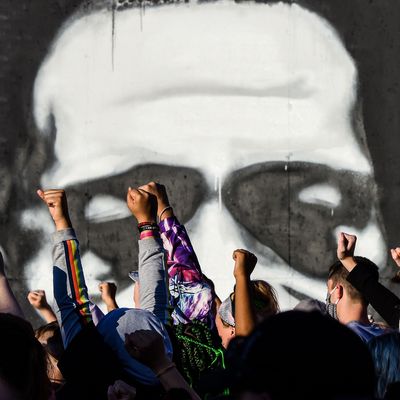
When Deonte Abu Bakr Bryant lost his car to a fire during the Minneapolis protests, he also lost his home. He’d been living in it for years, scratching out a living not far from where police officers killed George Floyd. But he thinks he’s found a new place to live, he told New York. He’s moved into what used to be a Sheraton Hotel, along with hundreds of other unhoused people in the city. “They had a name on the Sheraton, called Sanctuary,” he said. He went inside to use the restroom, asked some questions, and discovered, to his relief, that organizers were turning the hotel into a home.
Bryant’s situation stems from long-standing problems in the Twin City region, organizers said. Housing scarcity and an aggressive police force already threatened the most vulnerable people in Minneapolis. Then COVID-19 happened, and after it, the protests, which met a brutal reaction from local law enforcement. The killing of George Floyd brought interlocking issues to the fore. As organizers put it, homelessness, like police brutality, is another problem that local officials have been too slow to resolve.
But at least there’s the Sheraton. Local activists had already rented a room there for a couple who needed shelter, organizer Rosemary Fister told New York. As protests encroached, the hotel’s owner evacuated it on Saturday. But the couple decided to remain. “The community showed up to help them stay, and open it as a sanctuary for other people who also needed a safe place to be,” she explained.
According to a study produced by Wilder Research, homelessness in Minnesota increased by 10 percent from 2015 to 2018, reaching its highest number in three decades. That’s partly because the state is suffering a significant housing shortage, and in the Twin City region, the problem is acute. Resources, meanwhile, can be scarce. In 2019, Minneapolis officials closed a major shelter, called a navigation center, and left many residents without housing. As protests escalated, the region’s Metropolitan Council cleared a large encampment in what it characterized as a health and security measure. But without Camp Quarantine, as its residents dubbed it, there were few options available. Other encampments were also being cleared. City shelters can have long waiting lists, and they’d already lost access to libraries and other public buildings because of the pandemic, the Minneapolis Star-Tribune reported. Now they had nowhere to sleep.
Fister estimated that the former Sheraton is now home to around 250 people, with another 100 on a waiting list. The hotel’s owner, identified in local media reports as Jay Patel, “has been extraordinarily gracious,” she said, and “an active participant in the work that we’re doing.” A different organizer told MinnPost.com that Patel, who only bought the hotel three months ago, has helped them make key cards for the new guests. Fister said organizers are also “in conversation” with Unite Here Local 17, which represents the Sheraton’s workers.
Representatives for Unite Here Local 17 couldn’t be reached for comment by press time. But Fister said that residents intend to stay in the Sheraton for good, and organizers are talking to the owner, Jay Patel, to figure out how that transition would work. “This isn’t a shelter,” she added. “This isn’t temporary. We’re holding space so that residents can have control over their own living situation.”
Bryant, meanwhile, also hopes he can stay in the Sheraton for a long time. “Other places I’ve been to are sort of hard,” he said. “And this is more homely. You can go and turn your own key. I’ve never been to a shelter where you can turn your own key. It’s a bit of a difference, you know?”






























